Color Perspectives in Aquatic Explorations: Unveiling Innate Color Preferences and Psychoactive Responses in Freshwater Crayfish
Abstract
:1. Introduction
2. Materials and Methods
2.1. Animal Husbandry
2.2. Antidepressant Exposure
2.3. Instrument Setting used to Measure Achromatic and Color Preference
2.4. Video Taping and Trajectory Analysis by using UMATracker
2.5. Calculation of Color Preference Index
2.6. Statistical Analysis
3. Results
3.1. Achromatic Color Schemes Preference in Different Crayfish Species
3.2. Standard Color Preference Test in Two Crayfish Species
3.3. Color Preference in Juvenile American Crayfish
3.4. Color Preference in American Crayfish of Different Sexes
3.5. Color Preference Alterations after Antidepressant Exposure
4. Discussion
5. Conclusions
Author Contributions
Funding
Institutional Review Board Statement
Informed Consent Statement
Data Availability Statement
Acknowledgments
Conflicts of Interest
Appendix A
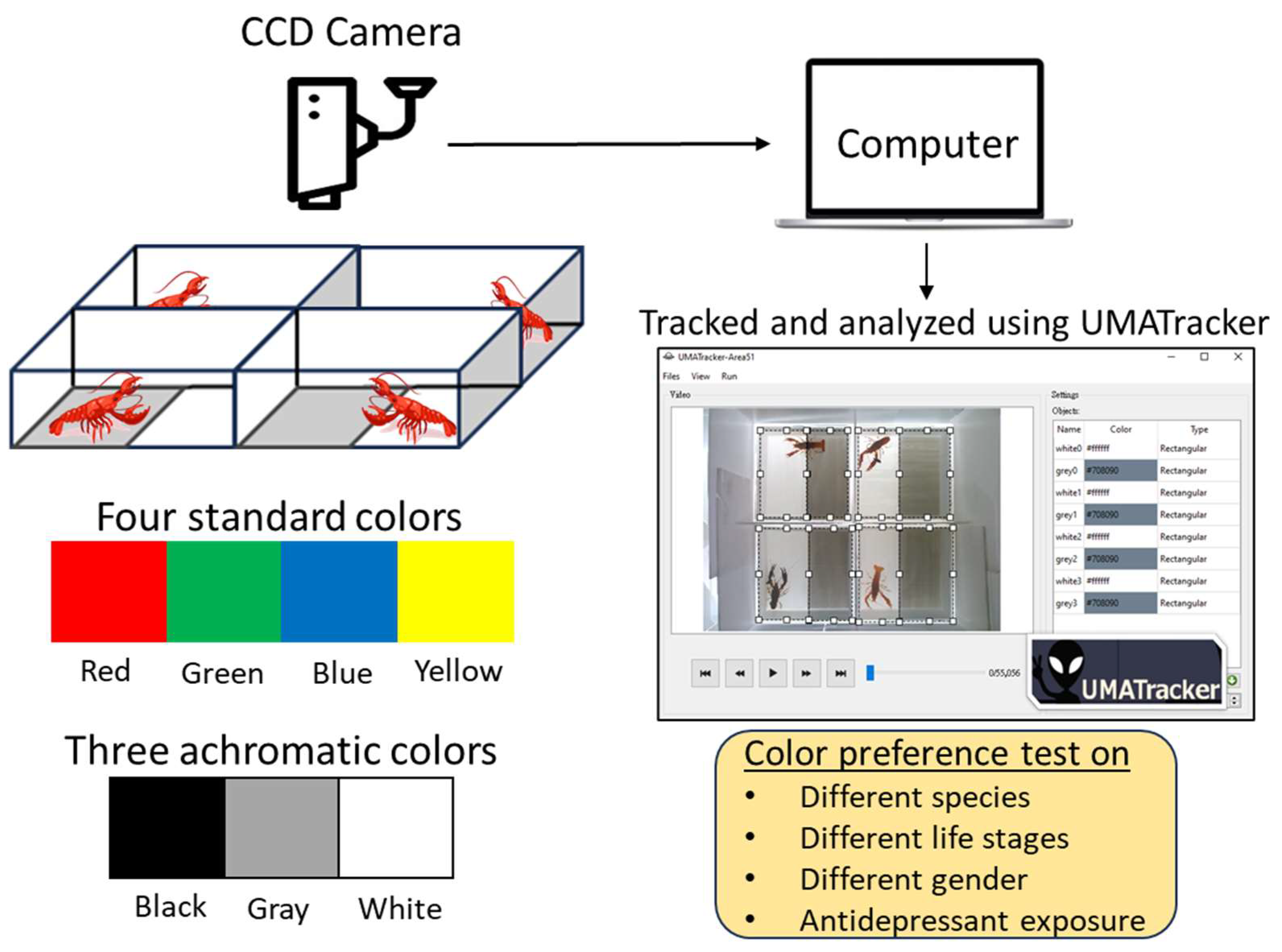
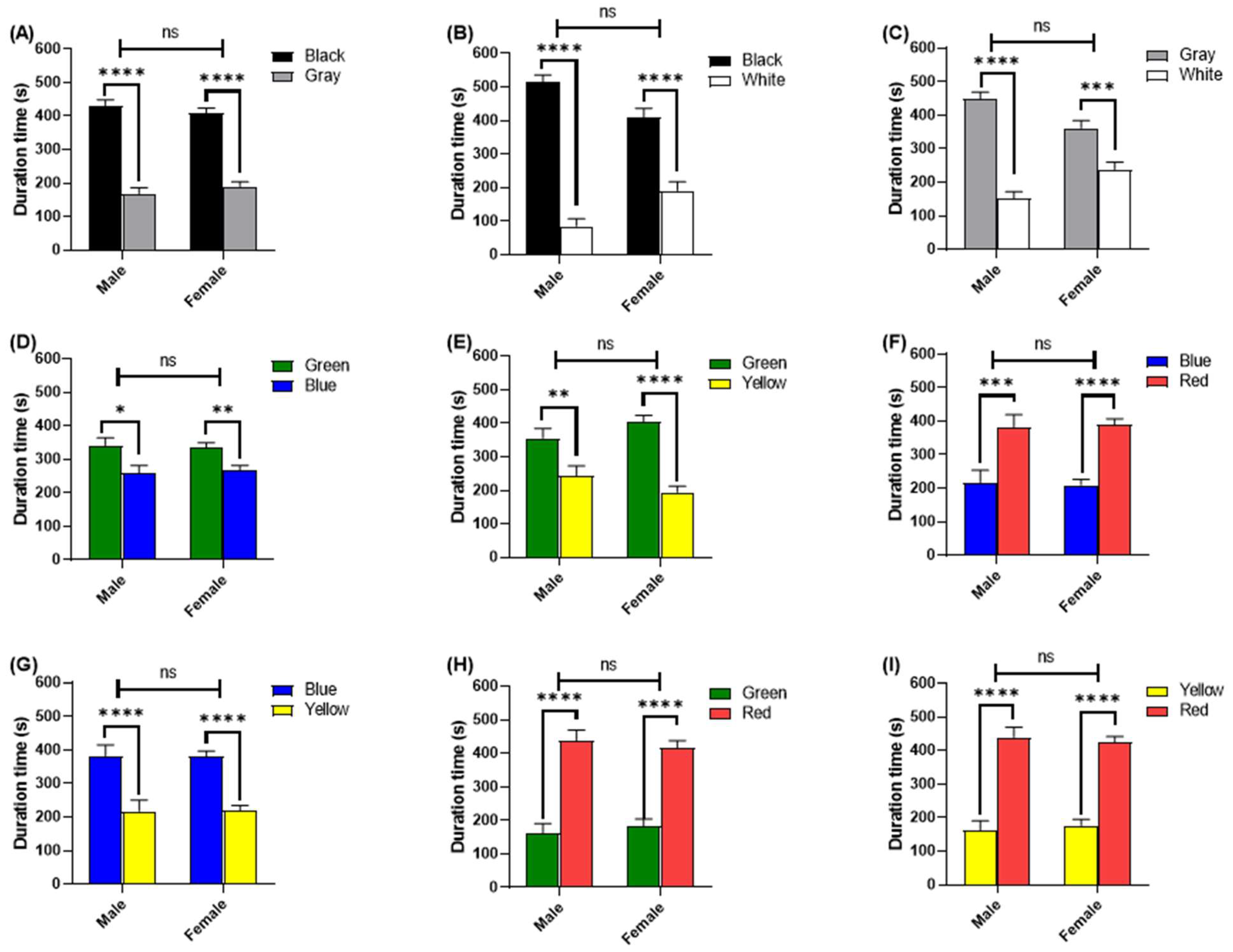
| Species | Color Preference | Instrumental Setting | Reference |
|---|---|---|---|
| Litopenaeus vannamei | L. vannamei prefer blue color pellets | Determine the involvement of color vision by food color preference | Kawamura et al., 2017 [66] |
| Callinectes sapidus | Males significantly preferred red-clawed females to orange-clawed females | Behavioral experiments evaluating male color preference toward photographs of female crabs with sexually receptive posture | Baldwin, J and Johnsen, S., 2012 [54] |
| Eriocheir sinensis | The crabs showed no food color preference | The food color preference of E. sinensis was observed using several foods dyed in different colors | Chen et al., 2023 [67] |
| Macrobrachium rosenbergii | The number of larvae was highest around the dark blue, light blue, and white beads; lowest around the black, red, and light green beads. | Plastic beads (4.1 mm in diameter) of different colors (dark blue, light blue, light green, yellow, red, white, black, and gray) in various combinations | Kawamura et al., 2016 [34] |
| Pacifastacus leniusculus | Crayfish were not attracted by the light, which was indicated by the lower catches in traps | Catch per unit effort (CPUE) comparison with white and green LED lights attached inside the baited traps or baited traps without light | Roukonen et al., 2021 [68] |
| Cambarus chasmodactylus and Orconectes cristavarius | O. cristavarius sheltering behavior significantly increased when exposed to both cool and warm spectrum LEDs at 2000 h. | Exposed those crayfish to cool (5000 K)- and warm (3000 K)-spectrum LED lights at ecologically relevant intensities of 15 lx in a laboratory experiment | Fischer, J. R., 2016 [69] |
| Procambarus clarkii and Orconectes australis | Crayfish have a statistically significant preference for a black- colored bottom over white | The black and white substrates preference experiment | Bierbower, S. M., 2010 [70] |
| Color | Wavelength Spectrum (nm) and Maximum Wavelength | Irradiance (uWatt/nm) | Reflectance (%) |
|---|---|---|---|
| White | 380–700 (561) | 0.000691 | 100 |
| Gray | 400–700 (564) | 0.000207 | 96 |
| Black | 500–700 (588) | 0.0000342 | 80 |
| Blue | 450–485 (456) | 0.000358 | 98 |
| Green | 500–565 (541) | 0.000376 | 100 |
| Yellow | 565–590 (572) | 0.000587 | 99 |
| Red | 625–740 (625) | 0.000489 | 97 |
| Colors | Number of Switching between Different Colors (Means ± SEM) | t Value | p Value | Significance | |
|---|---|---|---|---|---|
| Control | Sertraline | ||||
| Green–Blue | 16.92 ± 2.317 | 23.75 ± 4.331 | 1.391 | 0.1781 | n.s. |
| Green–Yellow | 14.50 ± 1.960 | 21.00 ± 3.174 | 1.742 | 0.0954 | n.s. |
| Blue–Red | 15.25 ± 2.980 | 19.33 ± 4.809 | 0.7218 | 0.4780 | n.s. |
| Yellow–Blue | 11.50 ± 2.337 | 28.17 ± 7.486 | 2.125 | 0.0450 | ✱ |
| Green–Red | 13.00 ± 2.146 | 23.58 ± 3.201 | 2.746 | 0.0118 | ✱ |
| Yellow–Red | 12.00 ± 2.629 | 30.00 ± 3.155 | 4.383 | 0.0002 | ✱✱✱ |
| Black–White | 17.33 ± 6.844 | 58.67 ± 10.00 | 3.410, | 0.0025 | ✱✱ |
| Gray–White | 13.50 ± 1.952 | 38.83 ± 12.46 | 2.009 | 0.0570 | n.s. |
| Black–Gray | 8.583 ± 2.017 | 46.58 ± 10.05 | 3.707 | 0.0012 | ✱✱ |
| Color Preference (Color 1 vs. Color 2) | Group | Difference Between Means ± Standard Error (Color 2—Color 1) | t Value | p Value | Significance |
|---|---|---|---|---|---|
| Green vs. Blue | P. clarkii | −82.73 ± 31.71 | 2.609 | 0.0129 | ✱ |
| C. quadricarinatus | 55.37 ± 35.25 | 1.571 | 0.1245 | n.s. | |
| Females | 67.31 ± 21.62 | 3.113 | 0.0035 | ✱✱ | |
| Males | 75.55 ± 32.18 | 2.348 | 0.0242 | ✱ | |
| Juvenile | 18.91 ± 17.92 | 1.055 | 0.2968 | n.s. | |
| Sertraline | −14.01 ± 49.86 | 0.2809 | 0.7814 | n.s. | |
| Green vs. Yellow | P. clarkii | −111.4 ± 40.31 | 2.764 | 0.0088 | ✱✱ |
| C. quadricarinatus | 355.8 ± 26.59 | 13.38 | <0.0001 | ✱✱✱✱ | |
| Females | −210.4 ± 25.53 | 8.243 | <0.0001 | ✱✱✱✱ | |
| Males | −121.0 ± 39.57 | 3.058 | 0.0041 | ✱✱ | |
| Juvenile | −27.58 ± 12.06 | 2.287 | 0.0269 | ✱ | |
| Sertraline | −82.47 ± 46.69 | 1.766 | 0.0912 | n.s. | |
| Blue vs. Red | P. clarkii | 165.5 ± 51.84 | 3.193 | 0.0028 | ✱✱ |
| C. quadricarinatus | −79.76 ± 62.72 | 1.272 | 0.2112 | n.s. | |
| Females | 180.6 ± 24.25 | 7.446 | <0.0001 | ✱✱✱✱ | |
| Males | 188.0 ± 43.37 | 4.333 | 0.0001 | ✱✱✱ | |
| Juvenile | 20.80 ± 19.22 | 1.082 | 0.2848 | n.s. | |
| Sertraline | 116.5 ± 69.10 | 1.686 | 0.1059 | n.s. | |
| Yellow vs. Blue | P. clarkii | 164.9 ± 46.49 | 3.548 | 0.0011 | ✱✱ |
| C. quadricarinatus | 353.5 ± 46.91 | 7.536 | <0.0001 | ✱✱✱✱ | |
| Females | −163.0 ± 22.08 | 7.382 | <0.0001 | ✱✱✱✱ | |
| Males | −214.3 ± 40.85 | 5.246 | <0.0001 | ✱✱✱✱ | |
| Juvenile | 72.92 ± 15.26 | 4.777 | <0.0001 | ✱✱✱✱ | |
| Sertraline | −49.10 ± 69.62 | 0.7052 | 0.4881 | n.s. | |
| Green vs. Red | P. clarkii | 277.9 ± 42.20 | 6.587 | <0.0001 | ✱✱✱✱ |
| C. quadricarinatus | 93.41 ± 41.77 | 2.236 | 0.0313 | ✱ | |
| Females | 233.4 ± 30.00 | 7.779 | <0.0001 | ✱✱✱✱ | |
| Males | 280.5 ± 41.76 | 6.716 | <0.0001 | ✱✱✱✱ | |
| Juvenile | 94.93 ± 25.75 | 3.686 | 0.0006 | ✱✱✱ | |
| Sertraline | 105.8 ± 49.94 | 2.120 | 0.0456 | ✱ | |
| Yellow vs. Red | P. clarkii | 279.2 ± 42.28 | 6.604 | <0.0001 | ✱✱✱✱ |
| C. quadricarinatus | 305.9 ± 42.01 | 7.281 | <0.0001 | ✱✱✱✱ | |
| Females | 246.8 ± 26.16 | 9.437 | <0.0001 | ✱✱✱✱ | |
| Males | 325.7 ± 34.12 | 9.544 | <0.0001 | ✱✱✱✱ | |
| Juvenile | 89.31 ± 24.89 | 3.589 | 0.0008 | ✱✱✱ | |
| Sertraline | 173.7 ± 52.19 | 3.329 | 0.0030 | ✱✱ | |
| Black vs. White | P. clarkii | −428.9 ± 30.41 | 14.11 | <0.0001 | ✱✱✱✱ |
| C. quadricarinatus | −417.8 ± 18.11 | 23.08 | <0.0001 | ✱✱✱✱ | |
| Females | −218.7 ± 37.72 | 5.796 | <0.0001 | ✱✱✱✱ | |
| Males | −459.9 ± 18.57 | 24.77 | <0.0001 | ✱✱✱✱ | |
| Juvenile | −242.1 ± 29.68 | 8.159 | <0.0001 | ✱✱✱✱ | |
| Sertraline | −148.0 ± 44.82 | 3.303 | 0.0032 | ✱✱ | |
| Gray vs. White | P. clarkii | −296.9 ± 28.38 | 10.46 | <0.0001 | ✱✱✱✱ |
| C. quadricarinatus | −430.3 ± 29.82 | 14.43 | <0.0001 | ✱✱✱✱ | |
| Females | −124.0 ± 31.74 | 3.907 | 0.0004 | ✱✱✱ | |
| Males | −340.0 ± 16.90 | 20.12 | <0.0001 | ✱✱✱✱ | |
| Juvenile | −94.56 ± 17.89 | 5.286 | <0.0001 | ✱✱✱✱ | |
| Sertraline | −85.64 ± 58.31 | 1.469 | 0.1561 | n.s. | |
| Black vs. Gray | P. clarkii | −423.4 ± 22.67 | 18.68 | <0.0001 | ✱✱✱✱ |
| C. quadricarinatus | −372.7 ± 32.35 | 11.52 | <0.0001 | ✱✱✱✱ | |
| Females | −219.5 ± 19.36 | 11.34 | <0.0001 | ✱✱✱✱ | |
| Males | −262.4 ± 23.94 | 10.96 | <0.0001 | ✱✱✱✱ | |
| Juvenile | −103.8 ± 26.63 | 3.900 | 0.0003 | ✱✱✱ | |
| Sertraline | −2.707 ± 65.22 | 0.04151 | 0.9673 | n.s. |
References
- Park, J.-S.; Ryu, J.-H.; Choi, T.-I.; Bae, Y.-K.; Lee, S.; Kang, H.J.; Kim, C.-H. Innate color preference of zebrafish and its use in behavioral analyses. Mol. Cells 2016, 39, 750. [Google Scholar] [CrossRef]
- Hunt, J.E.; Bruno, J.R.; Pratt, K.G. An Innate Color Preference Displayed by Xenopus Tadpoles Is Persistent and Requires the Tegmentum. Front. Behav. Neurosci. 2020, 14, 71. [Google Scholar] [CrossRef] [PubMed]
- Gatto, E.; Bruzzone, M.; Lucon-Xiccato, T. Innate visual discrimination abilities of zebrafish larvae. Behav. Process. 2021, 193, 104534. [Google Scholar] [CrossRef] [PubMed]
- Roy, T.; Suriyampola, P.S.; Flores, J.; López, M.; Hickey, C.; Bhat, A.; Martins, E.P. Color preferences affect learning in zebrafish, Danio rerio. Sci. Rep. 2019, 9, 14531. [Google Scholar] [CrossRef] [PubMed]
- Rodd, F.H.; Hughes, K.A.; Grether, G.F.; Baril, C.T. A possible non-sexual origin of mate preference: Are male guppies mimicking fruit? Proc. R. Soc. London. Ser. B Biol. Sci. 2002, 269, 475–481. [Google Scholar] [CrossRef] [PubMed]
- Luchiari, A.; Pirhonen, J. Effects of ambient colour on colour preference and growth of juvenile rainbow trout Oncorhynchus mykiss (Walbaum). J. Fish Biol. 2008, 72, 1504–1514. [Google Scholar] [CrossRef]
- Volpato, G.L.; Barreto, R. Environmental blue light prevents stress in the fish Nile tilapia. Braz. J. Med. Biol. Res. 2001, 34, 1041–1045. [Google Scholar] [CrossRef] [PubMed]
- Siregar, P.; Juniardi, S.; Audira, G.; Lai, Y.-H.; Huang, J.-C.; Chen, K.H.-C.; Chen, J.-R.; Hsiao, C.-D. Method Standardization for Conducting Innate Color Preference Studies in Different Zebrafish Strains. Biomedicines 2020, 8, 271. [Google Scholar] [CrossRef] [PubMed]
- Lazopulo, S.; Lazopulo, A.; Baker, J.D.; Syed, S. Daytime colour preference in Drosophila depends on the circadian clock and TRP channels. Nature 2019, 574, 108–111. [Google Scholar] [CrossRef]
- Gumbert, A. Color choices by bumble bees (Bombus terrestris): Innate preferences and generalization after learning. Behav. Ecol. Sociobiol. 2000, 48, 36–43. [Google Scholar] [CrossRef]
- Kelber, A. Innate preferences for flower features in the hawkmoth Macroglossum stellatarum. J. Exp. Biol. 1997, 200, 827–836. [Google Scholar] [CrossRef] [PubMed]
- Hess, E.H. Natural preferences of chicks and ducklings for objects of different colors. Psychol. Rep. 1956, 2, 477–483. [Google Scholar] [CrossRef]
- Moriya, T.; Kito, K.; Miyashita, Y.; Asami, K. Preference for background color of the Xenopus laevis tadpole. J. Exp. Zool. 1996, 276, 335–344. [Google Scholar] [CrossRef]
- Rothman, G.R.; Blackiston, D.J.; Levin, M. Color and intensity discrimination in Xenopus laevis tadpoles. Anim. Cogn. 2016, 19, 911–919. [Google Scholar] [CrossRef] [PubMed]
- Karplus, I.; Samuel, D. The effect of exposure to black background and to α-MSH on black-white background preference in the amphibian Xenopus laevis (Daudin). Horm. Behav. 1978, 11, 151–159. [Google Scholar] [CrossRef]
- Chapman, R.M. Light wavelength and energy preferences of the bullfrog: Evidence for color vision. J. Comp. Physiol. Psychol. 1966, 61, 429. [Google Scholar] [CrossRef]
- Kelber, A.; Vorobyev, M.; Osorio, D. Animal colour vision–behavioural tests and physiological concepts. Biol. Rev. 2003, 78, 81–118. [Google Scholar] [CrossRef]
- Chow, K.-L.; Leiman, A.L. The photo-sensitive organs of crayfish and brightness learning. Behav. Biol. 1972, 7, 25–35. [Google Scholar] [CrossRef]
- Daly, I.M.; Tetley, A.E.; Jared, S.L.; How, M.J.; Roberts, N.W. Colour preference in Odontodactylus scyllarus (Linnaeus, 1758)(Stomatopoda). J. Crustac. Biol. 2017, 37, 374–379. [Google Scholar] [CrossRef]
- Kawamura, G.; Yong, A.S.K.; Roy, D.C.; Lim, L.-S. Shelter colour preference in the purple mud crab Scylla tranquebarica (Fabricius). Appl. Anim. Behav. Sci. 2020, 225, 104966. [Google Scholar] [CrossRef]
- Camilleri, J. Leaf choice by crustaceans in a mangrove forest in Queensland. Mar. Biol. 1989, 102, 453–459. [Google Scholar] [CrossRef]
- Putra, M.D.; Bláha, M.; Wardiatno, Y.; Krisanti, M.; Jerikho, R.; Kamal, M.M.; Mojžišová, M.; Bystřický, P.K.; Kouba, A.; Kalous, L. Procambarus clarkii (Girard, 1852) and crayfish plague as new threats for biodiversity in Indonesia. Aquat. Conserv. Mar. Freshw. Ecosyst. 2018, 28, 1434–1440. [Google Scholar] [CrossRef]
- Jones, C.; Geddes, M.C. Australian freshwater crayfish: Exploitation by fishing and aquaculture. Aust. Biol. 1997, 10, 70–75. [Google Scholar]
- Zheng, X.; Liao, X.; Zhang, M.; Mao, J.; Chen, Y.; Lan, S.; Yin, Z.; Yu, F.; Vasquez, H.E.; Gu, Z. The effect of aquarium color background on the survival, growth performance, body coloration, and enzymatic activity of laboratory cultured Cherax quadricarinatus juveniles. Aquac. Rep. 2023, 32, 101699. [Google Scholar] [CrossRef]
- Toyota, K.; Usami, K.; Mizusawa, K.; Ohira, T. Effect of blue light on the growth of the red swamp crayfish Procambraus clarkii larvae-seasonal and sexual differences. Zool. Stud. 2022, 61, e3. [Google Scholar]
- Ilhéu, M.; Bernardo, J.M.; Fernandes, S. Predation of invasive crayfish on aquatic vertebrates: The effect of Procambarus clarkii on fish assemblages in Mediterranean temporary streams. In Biological Invaders in Inland Waters: Profiles, Distribution, and Threats; Springer: Berlin, Germany, 2007; pp. 543–558. [Google Scholar]
- Ahmadi, A. LED Light Trap Fishing as Alternative for Harvesting American Crayfish. SEAFDEC Fish People 2014, 12, 32–37. [Google Scholar]
- Yamanaka, O.; Takeuchi, R. UMATracker: An intuitive image-based tracking platform. J. Exp. Biol. 2018, 221, jeb182469. [Google Scholar] [CrossRef]
- Lau, B.Y.; Mathur, P.; Gould, G.G.; Guo, S. Identification of a brain center whose activity discriminates a choice behavior in zebrafish. Proc. Natl. Acad. Sci. USA 2011, 108, 2581–2586. [Google Scholar] [CrossRef]
- Marshall, N.J.; Cronin, T.W.; Frank, T.M. Visual adaptations in crustaceans: Chromatic, developmental, and temporal aspects. In Sensory Processing in Aquatic Environments; Springer: Berlin, Germany, 2003; pp. 343–372. [Google Scholar]
- Zaidi, Q.; Marshall, J.; Thoen, H.; Conway, B.R. Evolution of neural computations: Mantis shrimp and human color decoding. i-Perception 2014, 5, 492–496. [Google Scholar] [CrossRef]
- Thoen, H.H.; How, M.J.; Chiou, T.-H.; Marshall, J. A different form of color vision in mantis shrimp. Science 2014, 343, 411–413. [Google Scholar] [CrossRef]
- Baldwin, J.; Johnsen, S. The importance of color in mate choice of the blue crab Callinectes sapidus. J. Exp. Biol. 2009, 212, 3762–3768. [Google Scholar] [CrossRef]
- Kawamura, G.; Bagarinao, T.; Yong, A.S.K.; Jeganathan, I.M.X.; Lim, L.-S. Colour preference and colour vision of the larvae of the giant freshwater prawn Macrobrachium rosenbergii. J. Exp. Mar. Biol. Ecol. 2016, 474, 67–72. [Google Scholar] [CrossRef]
- Kazilek, C.; Cooper, K. Colors Animals See. 2009. Available online: https://askabiologist.asu.edu/colors-animals-see (accessed on 2 March 2023).
- Nosaki, H. Electrophysiological study of color encoding in the compound eye of crayfish, Procambarus clarkii. Z. Vgl. Physiol. 1969, 64, 318–323. [Google Scholar] [CrossRef]
- Mason, J.C. Maternal-offspring behavior of the crayfish, Pacifastacus trowbridgi (Stimpson). Am. Midl. Nat. 1970, 84, 463–473. [Google Scholar] [CrossRef]
- Martin III, A.L.; Moore, P.A. The influence of dominance on shelter preference and eviction rates in the crayfish, Orconectes rusticus. Ethology 2008, 114, 351–360. [Google Scholar] [CrossRef]
- Promer, H.; Wagner, G.; Smith, M.; Hansen, M. Substrate Preference in Orconectes rusticus: Does Size Matter? University of Winsconsin: Madison, WI, USA, 2014. [Google Scholar]
- Blank, G.S.; Figler, M.H. Interspecific shelter competition between the sympatric crayfish species Procambarus clarkii (Girard) and Procambarus zonangulus (Hobbs and Hobbs). J. Crustac. Biol. 1996, 16, 300–309. [Google Scholar] [CrossRef]
- Abeel, T.; Vervaecke, H.; Roelant, E.; Platteaux, I.; Adriaen, J.; Durinck, G.; Meeus, W.; Van de Perre, L.; Aerts, S. 37. Evaluation of the influence of light conditions on crayfish welfare in intensive aquaculture. Food Futures 2016, 244, 244–250. [Google Scholar]
- Fossat, P.; Bacqué-Cazenave, J.; De Deurwaerdère, P.; Delbecque, J.-P.; Cattaert, D. Anxiety-like behavior in crayfish is controlled by serotonin. Science 2014, 344, 1293–1297. [Google Scholar] [CrossRef]
- Oltmann, J.P. Crayfish Behavior and Differential Response to Environmental Conditions; Worcester Polytechnic Institute: Worcester, MA, USA, 2010. [Google Scholar]
- Thacker, R.W.; Hazlett, B.A.; Esman, L.A.; Stafford, C.P.; Keller, T. Color morphs of the crayfish Orconectes virilis. Am. Midl. Nat. 1993, 129, 182–199. [Google Scholar] [CrossRef]
- Erko, M.; Hartmann, M.A.; Zlotnikov, I.; Serrano, C.V.; Fratzl, P.; Politi, Y. Structural and mechanical properties of the arthropod cuticle: Comparison between the fang of the spider Cupiennius salei and the carapace of American lobster Homarus americanus. J. Struct. Biol. 2013, 183, 172–179. [Google Scholar] [CrossRef]
- Schuster, G.A. Review of crayfish color patterns in the Family Cambaridae (Astacoidea), with discussion of their possible importance. Zootaxa 2020, 4755, zootaxa.4755.1.3. [Google Scholar] [CrossRef]
- Kent, W. The colors of the crayfish. Am. Nat. 1901, 35, 933–936. [Google Scholar] [CrossRef]
- Secker, H.L. Evidence of blue coloration in a population of Prairie crayfish (Procambarus gracilis (Bundy, 1876)(Decapoda, Cambaridae)) in northeastern Illinois, USA. Crustaceana 2013, 86, 313–321. [Google Scholar] [CrossRef]
- Li, H.; Cooper, R.L. The effect of ambient light on blind cave crayfish: Social interactions. J. Crustac. Biol. 2002, 22, 449–458. [Google Scholar] [CrossRef]
- Alberstadt, P.J.; Steele, C.W.; Skinner, C. Cover-seeking behavior in juvenile and adult crayfish, Orconectes rusticus: Effects of darkness and thigmotactic cues. J. Crustac. Biol. 1995, 15, 537–541. [Google Scholar] [CrossRef]
- Beingesser, K.R.; Copp, N.H. Differential diurnal distribution of Procambarus clarkii (Girard) juveniles and adults and possible adaptive value of color differences between them (Decapoda, Astacidea). Crustaceana 1985, 49, 164–172. [Google Scholar] [CrossRef]
- Smith, D.G. Pennak’s Freshwater Invertebrates of the United States: Porifera to Crustacea; John Wiley & Sons: Hoboken, NJ, USA, 2001. [Google Scholar]
- Bovbjerg, R.V. Some factors affecting aggressive behavior in crayfish. Physiol. Zool. 1956, 29, 127–136. [Google Scholar] [CrossRef]
- Baldwin, J.; Johnsen, S. The male blue crab, Callinectes sapidus, uses both chromatic and achromatic cues during mate choice. J. Exp. Biol. 2012, 215, 1184–1191. [Google Scholar] [CrossRef]
- Sacchi, R.; Cancian, S.; Ghia, D.; Fea, G.; Coladonato, A. Color variation in signal crayfish Pacifastacus leniusculus. Curr. Zool. 2021, 67, 35–43. [Google Scholar] [CrossRef] [PubMed]
- Carruthers, H.R.; Morris, J.; Tarrier, N.; Whorwell, P.J. The Manchester Color Wheel: Development of a novel way of identifying color choice and its validation in healthy, anxious and depressed individuals. BMC Med. Res. Methodol. 2010, 10, 1–13. [Google Scholar] [CrossRef]
- Zhang, S.; Liu, X.; Sun, M.; Zhang, Q.; Li, T.; Li, X.; Xu, J.; Zhao, X.; Chen, D.; Feng, X. Reversal of reserpine-induced depression and cognitive disorder in zebrafish by sertraline and Traditional Chinese Medicine (TCM). Behav. Brain Funct. 2018, 14, 1–14. [Google Scholar] [CrossRef]
- Constable, P.A.; Al-Dasooqi, D.; Bruce, R.; Prem-Senthil, M. A review of ocular complications associated with medications used for anxiety, depression, and stress. Clin. Optom. 2022, 14, 13–25. [Google Scholar] [CrossRef] [PubMed]
- Karavanich, C.; Atema, J. Individual recognition and memory in lobster dominance. Anim. Behav. 1998, 56, 1553–1560. [Google Scholar] [CrossRef]
- Kamran, M.; Moore, P.A. Comparative homing behaviors in two species of crayfish, Fallicambarus fodiens and Orconectes rusticus. Ethology 2015, 121, 775–784. [Google Scholar] [CrossRef]
- Dearing, B.G.; Singg, S. Photosensitive Assessment: A Study of Color Preference, Depression and Temperament. Subtle Energ. Energy Med. J. Arch. 1996, 7, 89–110. [Google Scholar]
- Barrett, L.F. How emotions are made: The Secret Life of the Brain; Pan Macmillan: London, UK, 2017. [Google Scholar]
- Woodman, S.; Steinkey, D.; Dew, W.; Burket, S.; Brooks, B.; Pyle, G. Effects of sertraline on behavioral indices of crayfish Orconectes virilis. Ecotoxicol. Environ. Saf. 2016, 134, 31–37. [Google Scholar] [CrossRef]
- Suryanto, M.E.; Luong, C.T.; Vasquez, R.D.; Roldan, M.J.M.; Hung, C.-H.; Ger, T.-R.; Hsiao, C.-D. Using crayfish behavior assay as a simple and sensitive model to evaluate potential adverse effects of water pollution: Emphasis on antidepressants. Ecotoxicol. Environ. Saf. 2023, 265, 115507. [Google Scholar] [CrossRef] [PubMed]
- Hossain, M.S.; Kubec, J.; Guo, W.; Roje, S.; Ložek, F.; Grabicová, K.; Randák, T.; Kouba, A.; Buřič, M. A combination of six psychoactive pharmaceuticals at environmental concentrations alter the locomotory behavior of clonal marbled crayfish. Sci. Total Environ. 2021, 751, 141383. [Google Scholar] [CrossRef]
- Kawamura, G.; Bagarinao, T.U.; Yong, A.S.K. Sensory systems and feeding behaviour of the giant freshwater prawn, Macrobrachium rosenbergii, and the marine whiteleg shrimp, Litopenaeus vannamei. Borneo J. Mar. Sci. Aquac. 2017, 1, 80–91. [Google Scholar] [CrossRef]
- Chen, Q.; Pang, Y.-Y.; Zhang, J.-Y.; Cheng, Y.-X.; Yang, X.-Z. The role of different sensory organs in the feeding behavior of Chinese mitten crab (Eriocheir sinensis). Aquaculture 2023, 566, 739231. [Google Scholar] [CrossRef]
- Ruokonen, T.J.; Niemi, A.; Suuronen, P.; Leskelä, A.; Keskinen, T. The effect of LED lights on trap catches in signal crayfish fisheries. Manag. Biol. Invasions 2021, 12, 654–661. [Google Scholar] [CrossRef]
- Fischer, J.R. The Behavioral Responses of Two Appalachian Crayfish to Cool and Warm Spectrum LED Light at Night; Appalachian State University: Boone, NC, USA, 2016. [Google Scholar]
- Bierbower, S.M. Environmental Effects on Behavior and Physiology in Crayfish; University of Kentucky: Lexington, KY, USA, 2010. [Google Scholar]
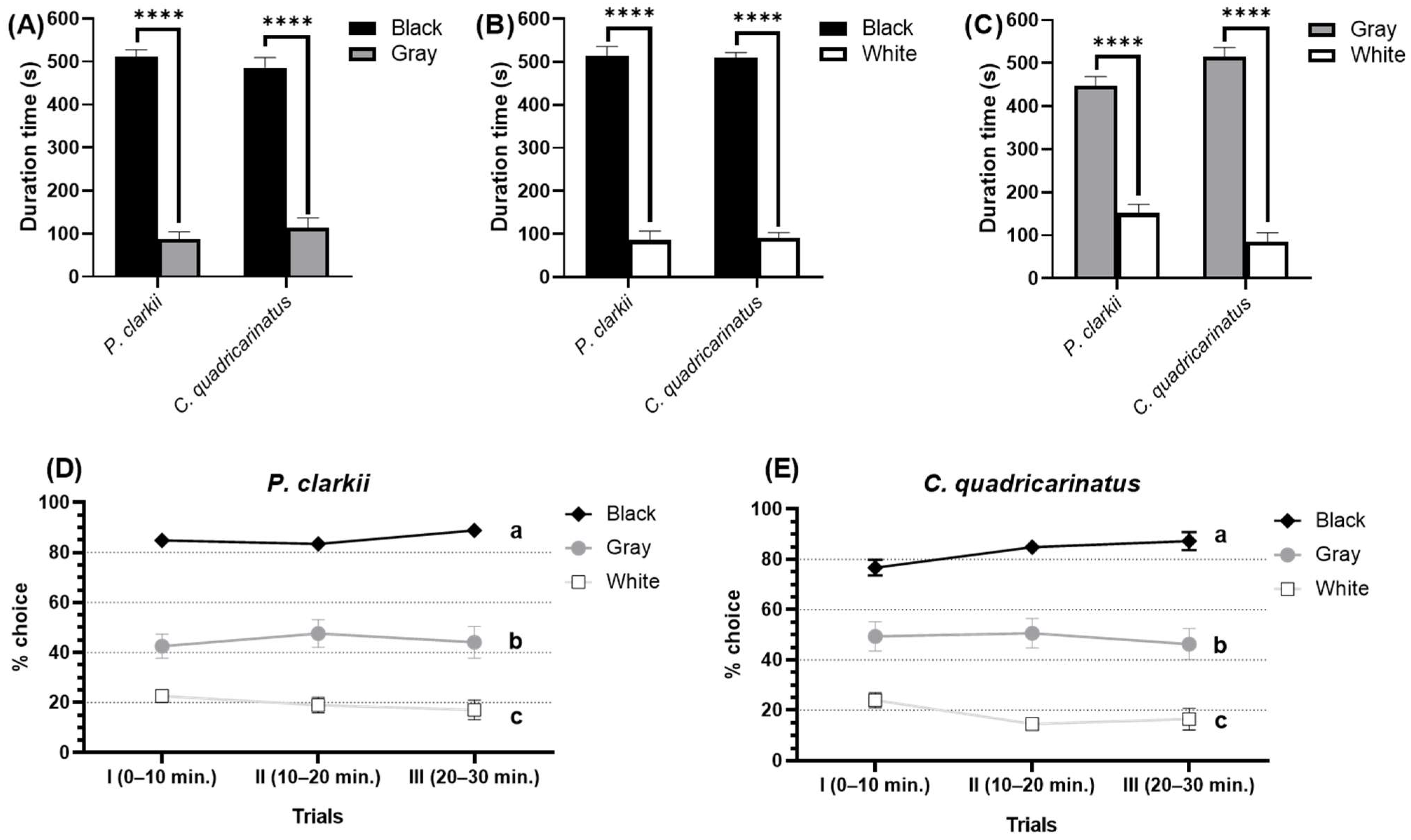
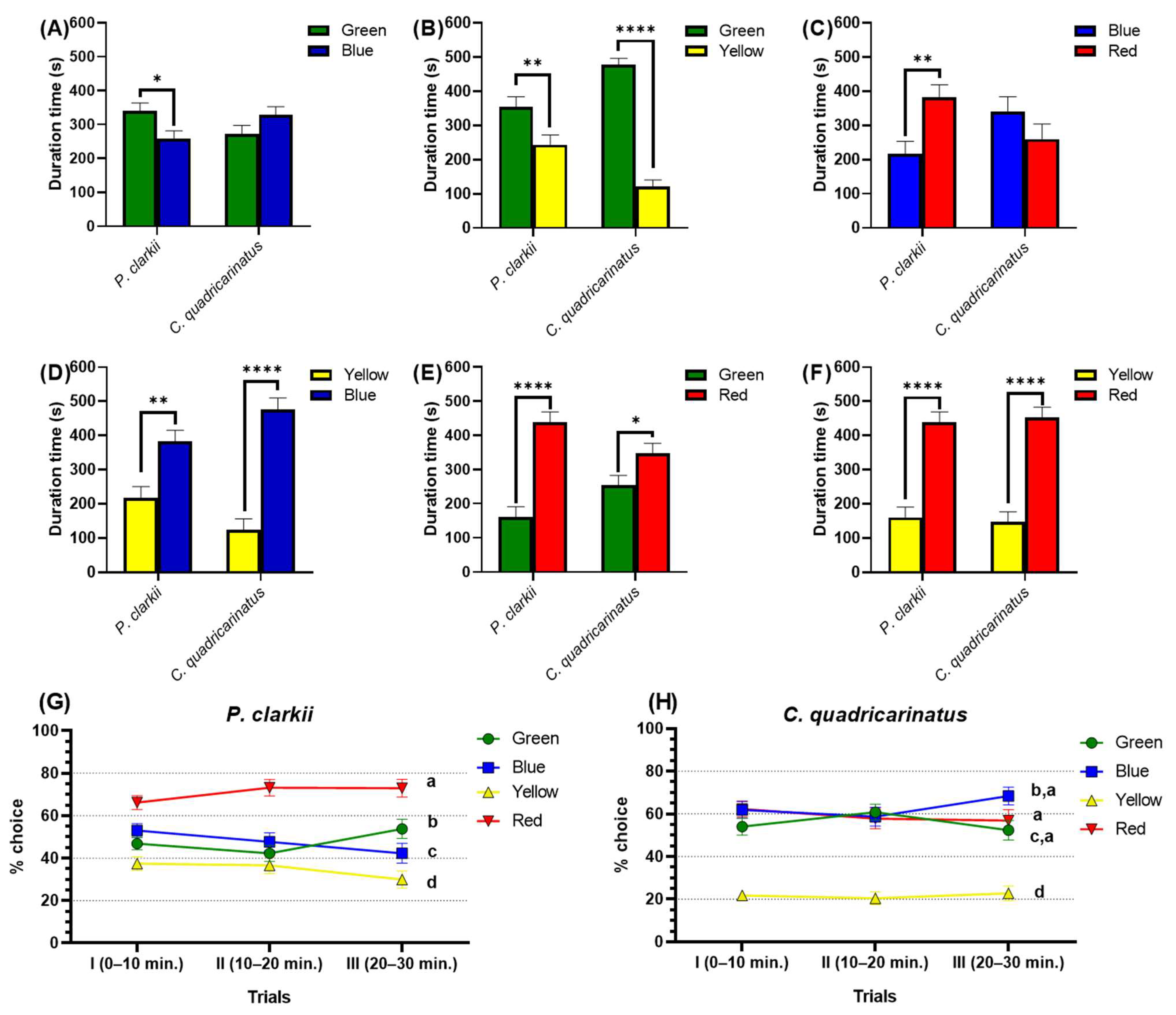

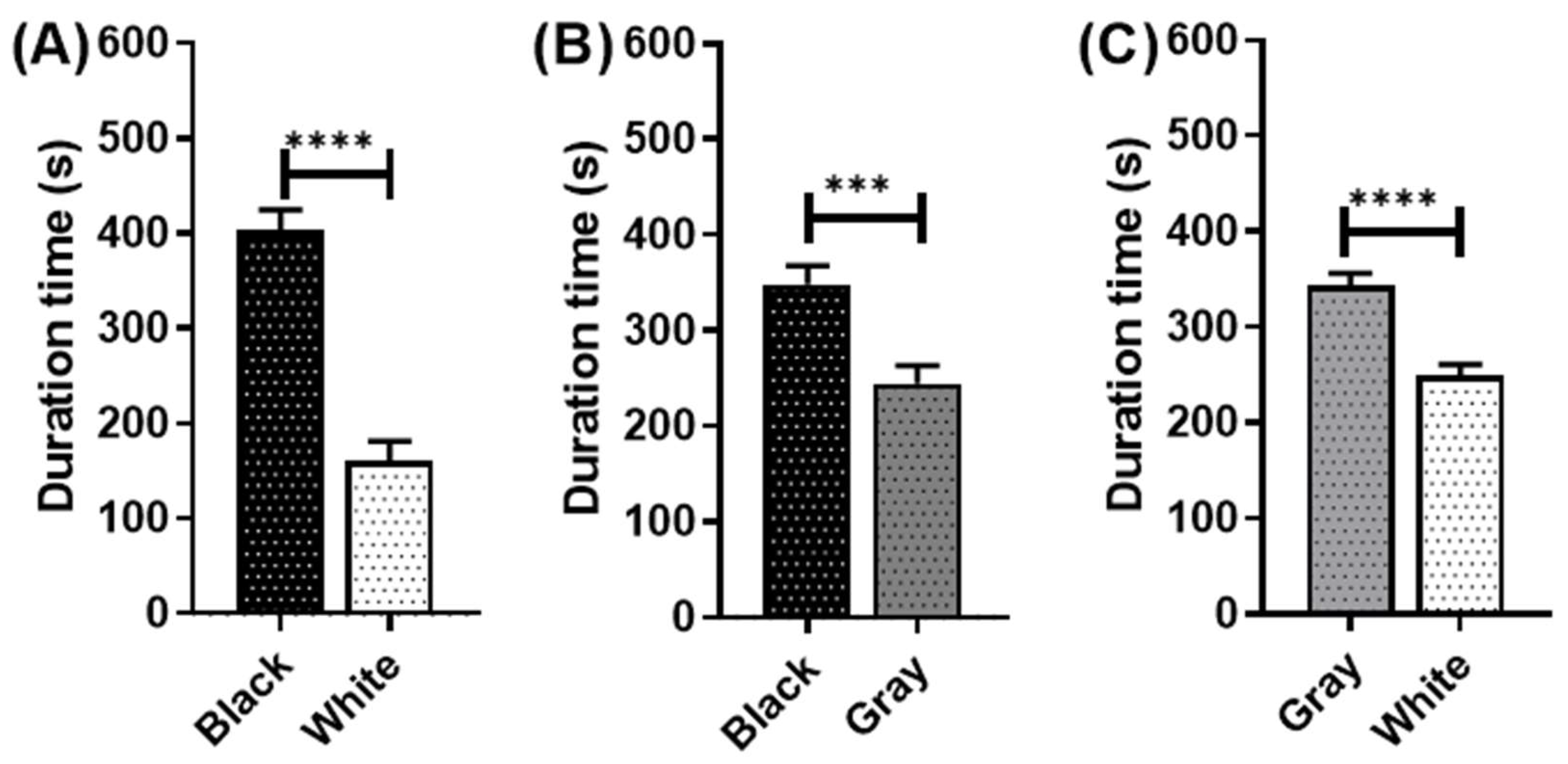
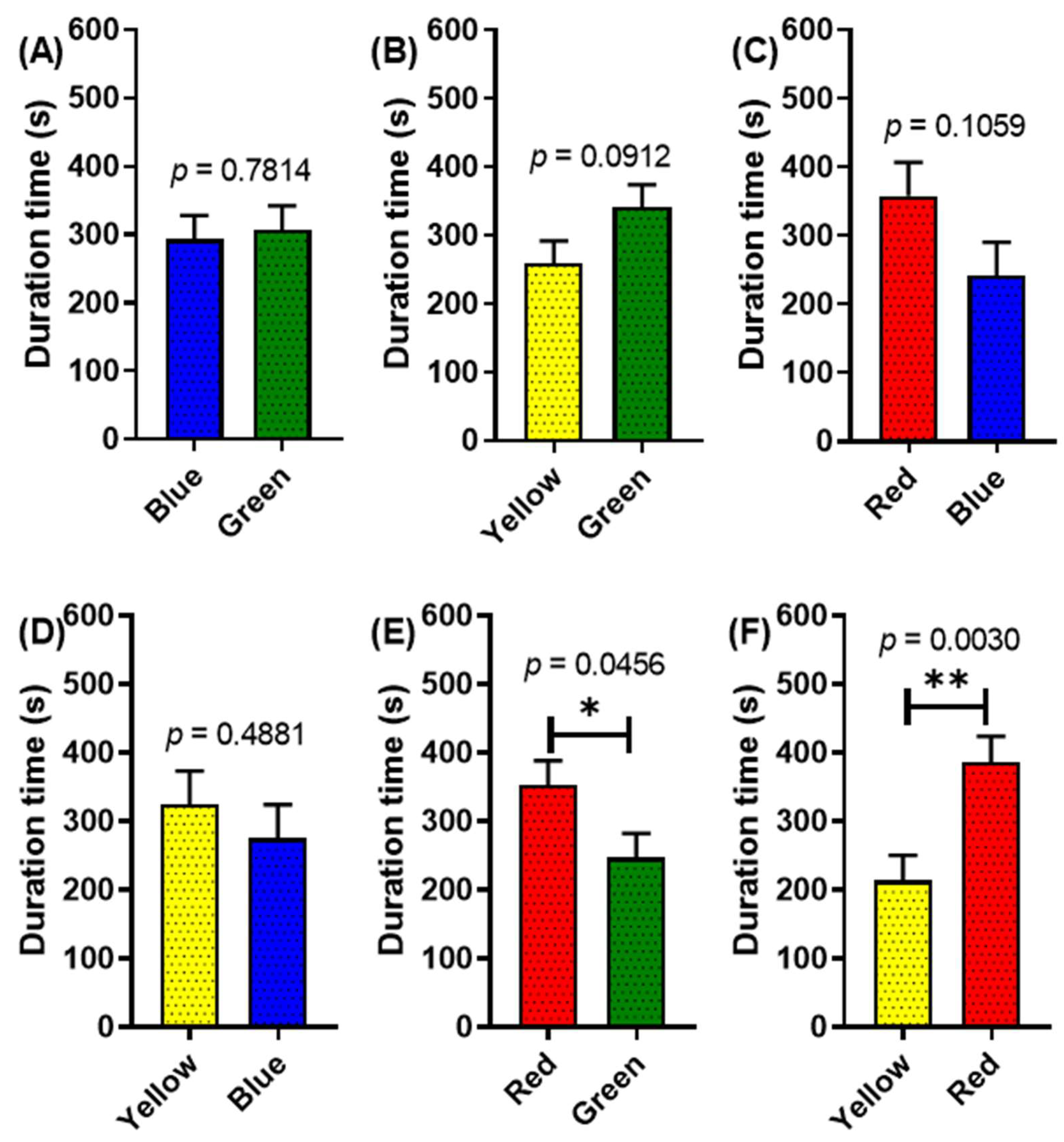

Disclaimer/Publisher’s Note: The statements, opinions and data contained in all publications are solely those of the individual author(s) and contributor(s) and not of MDPI and/or the editor(s). MDPI and/or the editor(s) disclaim responsibility for any injury to people or property resulting from any ideas, methods, instructions or products referred to in the content. |
© 2023 by the authors. Licensee MDPI, Basel, Switzerland. This article is an open access article distributed under the terms and conditions of the Creative Commons Attribution (CC BY) license (https://creativecommons.org/licenses/by/4.0/).
Share and Cite
Suryanto, M.E.; Audira, G.; Roldan, M.J.M.; Lai, H.-T.; Hsiao, C.-D. Color Perspectives in Aquatic Explorations: Unveiling Innate Color Preferences and Psychoactive Responses in Freshwater Crayfish. Toxics 2023, 11, 838. https://doi.org/10.3390/toxics11100838
Suryanto ME, Audira G, Roldan MJM, Lai H-T, Hsiao C-D. Color Perspectives in Aquatic Explorations: Unveiling Innate Color Preferences and Psychoactive Responses in Freshwater Crayfish. Toxics. 2023; 11(10):838. https://doi.org/10.3390/toxics11100838
Chicago/Turabian StyleSuryanto, Michael Edbert, Gilbert Audira, Marri Jmelou M. Roldan, Hong-Thih Lai, and Chung-Der Hsiao. 2023. "Color Perspectives in Aquatic Explorations: Unveiling Innate Color Preferences and Psychoactive Responses in Freshwater Crayfish" Toxics 11, no. 10: 838. https://doi.org/10.3390/toxics11100838
APA StyleSuryanto, M. E., Audira, G., Roldan, M. J. M., Lai, H.-T., & Hsiao, C.-D. (2023). Color Perspectives in Aquatic Explorations: Unveiling Innate Color Preferences and Psychoactive Responses in Freshwater Crayfish. Toxics, 11(10), 838. https://doi.org/10.3390/toxics11100838








